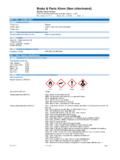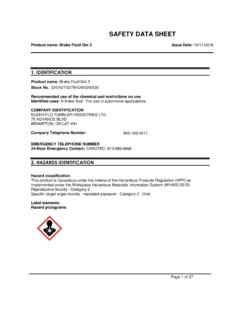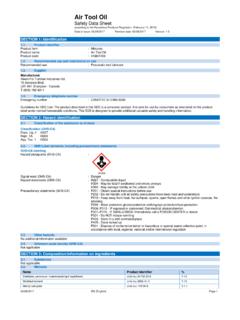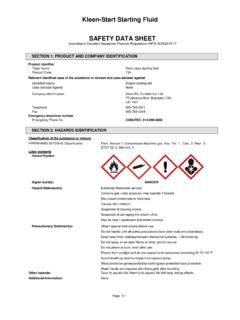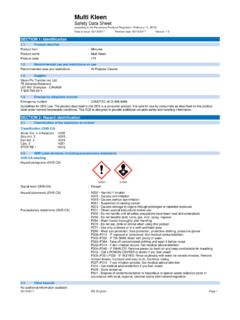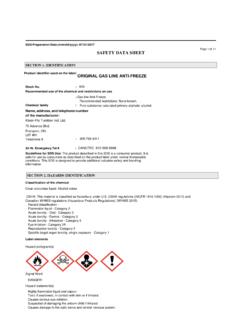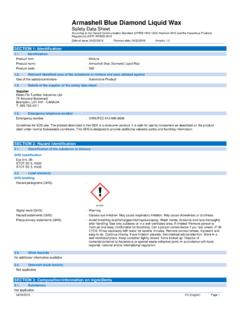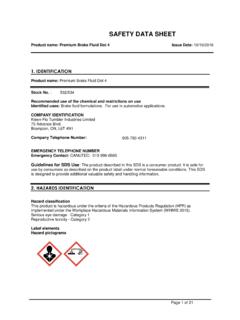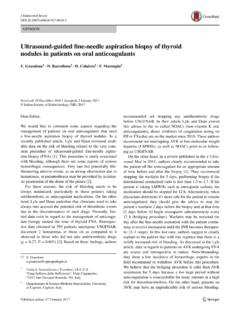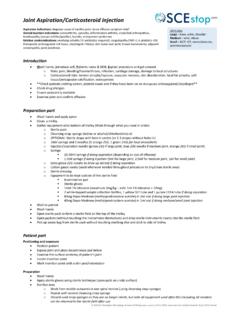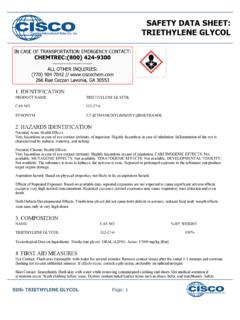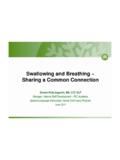Transcription of Direct Injection Intake Valve Cleaner - Kleen-Flo
1 Direct Injection Intake Valve Cleaner Safety Data Sheet according to the Hazardous Products Regulations (HPR) WHMIS 2015 Date of issue: 08/20/2015 Revision date: 08/20/2015 Version: SECTION 1: Identification of the substance/mixture and of the company/undertaking Product name : Direct Injection Intake Valve Cleaner Product code : 101 Use of the substance/mixture : Combustion Chamber and Intake Valve Cleaner Kleen-Flo Tumbler ind. Ltd. 75 Advance Boulevard L6T 4N1 Brampton - CANADA T 905-793-4311 Emergency number : CANUTEC (613) 996-6666 SECTION 2: Hazards identification GHS-CA classification Flammable liquids, Category 2 H225 Skin corrosion/irritation, Category 2 H315 Serious eye damage/eye irritation, Category 1 H318 Carcinogenicity, Category 2 H351 Reproductive toxicity, Category 2 H361 Specific target organ toxicity Single exposure, Category 3 H336 Specific target organ toxicity Repeated exposure, Category 1 H372 Aspiration hazard, Category 1 H304 Label elements GHS-CA labelling Hazard pictograms (GHS-CA) : GHS02 GHS05 GHS07 GHS08 Signal word (GHS-CA) : Danger Hazard statements (GHS-CA) : H225 - Highly flammable liquid and vapour.
2 H315 - Causes skin irritation. H318 - Causes serious eye damage. H351 - Suspected of causing cancer. H361 - Suspected of damaging fertility or the unborn child. H336 - May cause drowsiness or dizziness. H372 - Causes damage to organs through prolonged or repeated exposure. H304 - May be fatal if swallowed and enters airways. Precautionary statements (GHS-CA) : P210 - Keep away from heat, hot surfaces, sparks, open flames and other ignition sources. No smoking. P233 - Keep container tightly closed. P240 Ground and bond container and receiving equipment. P241 - Use explosion-proof electrical, ventilating, and lighting equipment. P242 - Use non-sparking tools. P243 - Take action to prevent static discharges. P264 - Wash hands thoroughly after handling. P201 - Obtain special instructions before use. P202 - Do not handle until all safety precautions have been read and understood.
3 P280 - Wear protective gloves, protective clothing, eye protection and face protection. P271 - Use only outdoors or in a well-ventilated area. P260 - Do not breathe dust, fume, gas, mist, vapours or spray. P270 - Do not eat, drink or smoke when using this product. P308+P313 - IF exposed or concerned: Get medical advice or attention. P303+P361+P364+P353 - IF ON SKIN (or hair): Take off immediately all contaminated clothing and wash it before reuse. Rinse skin with water or shower. P332+P313 - If skin irritation occurs: Get medical advice or attention. P305+P351+P338 - IF IN EYES: Rinse cautiously with water for several minutes. Remove contact lenses, if present and easy to do. Continue rinsing. 28/4/17 EN (English) Page 1 Product identifier Relevant identified uses of the substance or mixture and uses advised against Details of the supplier of the safety data sheet Emergency telephone number Classification of the substance or mixture Direct Injection Intake Valve Cleaner Safety Data Sheet according to the Hazardous Products Regulations (HPR) WHMIS 2015 28/4/17 EN (English) 2/7 P310 - Immediately call a POISON CENTER or doctor.
4 P304+P340 - IF INHALED: Remove person to fresh air and keep comfortable for breathing. P312 - Call a POISON CENTER or doctor if you feel unwell. P301+P310 - IF SWALLOWED: Immediately call a POISON CENTER or doctor. P331 - Do NOT induce vomiting. P403+P235 - Store in a well-ventilated place. Keep cool. P405 - Store locked up. P501 - Dispose of contents and container in accordance with local, regional, national, and international regulations. No additional information available. SECTION 3: Composition/information on ingredients Not applicable. Name Product identifier % Isopropyl alcohol (CAS No) 67-63-0 30-60 Xylenes (o-, m-, p- isomers) (CAS No) 1330-20-7 10-30 n-Heptane (CAS No) 142-82-5 10-30 2-Butoxyethanol (CAS No) 111-76-2 5-10 Ethylbenzene (CAS No) 100-41-4 3-7 Potassium hydroxide (CAS No) 1310-58-3 1-5 Ethanolamine (CAS No) 141-43-5 The exact concentration of the above listed chemicals are being withheld as a trade secret.
5 SECTION 4: First aid measures First-aid measures after inhalation : If breathing is difficult, remove victim to fresh air and keep at rest in a position comfortable for breathing. Get medical advice/attention if you feel unwell. First-aid measures after skin contact : In case of contact, immediately flush skin with plenty of water. Remove contaminated clothing and shoes. Wash clothing before reuse. Call a physician if irritation develops and persists. First-aid measures after eye contact : In case of contact, immediately flush eyes with plenty of water for at least 15 minutes. If easy to do, remove contact lenses, if worn. Get medical attention immediately. First-aid measures after ingestion : If swallowed, do NOT induce vomiting. Never give anything by mouth to an unconscious person. Rinse mouth. Get immediate medical advice or attention. Symptoms/injuries after inhalation : May cause respiratory tract irritation.
6 May cause drowsiness or dizziness. Symptoms/injuries after skin contact : Causes skin irritation. Symptoms may include redness, edema, drying, defatting and cracking of the skin. Symptoms/injuries after eye contact : Causes serious eye damage. Symptoms may include discomfort or pain, excess blinking and tear production, with marked redness and swelling of the conjunctiva. May cause burns. Symptoms/injuries after ingestion : May be fatal if swallowed and enters airways. This product may be aspirated into the lungs and cause chemical pneumonitis. May cause stomach distress, nausea or vomiting. Symptoms may not appear immediately. In case of accident or if you feel unwell, seek medical advice immediately (show the label or SDS where possible). SECTION 5: Firefighting measures Suitable extinguishing media : Dry chemical, Carbon dioxide, Foam. Unsuitable extinguishing media : None known.
7 Fire hazard : Products of combustion may include, and are not limited to: oxides of carbon. Highly flammable liquid and vapour. Explosion hazard : May form flammable or explosive vapour-air mixture. Protection during firefighting : Keep upwind of fire. Wear full fire fighting turn-out gear (full Bunker gear) and respiratory protection (SCBA). Use water spray to keep fire-exposed containers cool. SECTION 6: Accidental release measures General measures : Use personal protection recommended in Section 8. Isolate the hazard area and deny entry to unnecessary and unprotected personnel. Use special care to avoid static electric charges. Eliminate sources of ignition. Other hazards Substance Mixture Description of first aid measures Most important symptoms and effects, both acute and delayed Indication of any immediate medical attention and special treatment needed Extinguishing media Special hazards arising from the substance or mixture Advice for firefighters Personal precautions, protective equipment and emergency procedures Direct Injection Intake Valve Cleaner Safety Data Sheet according to the Hazardous Products Regulations (HPR) WHMIS 2015 28/4/17 EN (English) 3/7 No additional information available.
8 For containment : Contain and/or absorb spill with inert material ( sand, vermiculite), then place in a suitable container. Do not flush to sewer or allow to enter waterways. Use appropriate Personal Protective Equipment (PPE). Methods for cleaning up : Scoop up material and place in a disposal container. Absorb spillage to prevent material damage. Provide ventilation. See section 8 for further information on protective clothing and equipment and section 13 for advice on waste disposal. SECTION 7: Handling and storage Precautions for safe handling : Keep away from sources of ignition - No smoking. Avoid contact with skin and eyes. Avoid breathing dust, fume, gas, mist, vapours and spray. Do not swallow. Handle and open container with care. When using do not eat, drink or smoke. Take precautionary measures against static discharge. Use only non-sparking tools. Use personal protective equipment as required.
9 Use only outdoors or in a well-ventilated area. Hygiene measures : Launder contaminated clothing before reuse. Wash hands before eating, drinking, or smoking. Technical measures : Proper grounding procedures to avoid static electricity should be followed. Storage conditions : Keep out of the reach of children. Store in a dry, cool and well-ventilated area Keep container tightly closed. Do not expose to temperatures exceeding 50 C/ 122 F. Store away from Direct sunlight or other heat sources. Not available. SECTION 8: Exposure controls/personal protection Isopropyl alcohol (67-63-0) ACGIH ACGIH TWA (ppm) 200 ppm ACGIH ACGIH STEL (ppm) 400 ppm IDLH US IDLH (ppm) 2000 ppm (10% LEL) NIOSH NIOSH REL (TWA) (mg/m ) 980 mg/m NIOSH NIOSH REL (TWA) (ppm) 400 ppm NIOSH NIOSH REL (STEL) (mg/m ) 1225 mg/m NIOSH NIOSH REL (STEL) (ppm) 500 ppm Xylenes (o-, m-, p- isomers) (1330-20-7) ACGIH ACGIH TWA (ppm) 100 ppm ACGIH ACGIH STEL (ppm) 150 ppm n-Heptane (142-82-5) ACGIH ACGIH TWA (ppm) 400 ppm ACGIH ACGIH STEL (ppm) 500 ppm IDLH US IDLH (ppm) 750 ppm NIOSH NIOSH REL (TWA) (mg/m ) 350 mg/m NIOSH NIOSH REL (TWA) (ppm) 85 ppm NIOSH NIOSH REL (ceiling) (mg/m ) 1800 mg/m NIOSH NIOSH REL (ceiling) (ppm) 440 ppm 2-Butoxyethanol (111-76-2) ACGIH ACGIH TWA (ppm) 20 ppm IDLH US IDLH (ppm) 700 ppm NIOSH NIOSH REL (TWA) (mg/m ) 24 mg/m NIOSH NIOSH REL (TWA) (ppm) 5 ppm Ethylbenzene (100-41-4)
10 ACGIH ACGIH TWA (ppm) 20 ppm Environmental precautions Methods and material for containment and cleaning up Reference to other sections Precautions for safe handling Conditions for safe storage, including any incompatibilities Specific end use(s) Control parameters Direct Injection Intake Valve Cleaner Safety Data Sheet according to the Hazardous Products Regulations (HPR) WHMIS 2015 28/4/17 EN (English) 4/7 Ethylbenzene (100-41-4) IDLH US IDLH (ppm) 800 ppm (10% LEL) NIOSH NIOSH REL (TWA) (mg/m ) 435 mg/m NIOSH NIOSH REL (TWA) (ppm) 100 ppm NIOSH NIOSH REL (STEL) (mg/m ) 545 mg/m NIOSH NIOSH REL (STEL) (ppm) 125 ppm Potassium hydroxide (1310-58-3) ACGIH ACGIH Ceiling (mg/m ) 2 mg/m NIOSH NIOSH REL (ceiling) (mg/m ) 2 mg/m Ethanolamine (141-43-5) ACGIH ACGIH TWA (ppm) 3 ppm ACGIH ACGIH STEL (ppm) 6 ppm IDLH US IDLH (ppm) 30 ppm NIOSH NIOSH REL (TWA) (mg/m ) 8 mg/m NIOSH NIOSH REL (TWA) (ppm) 3 ppm NIOSH NIOSH REL (STEL) (mg/m ) 15 mg/m NIOSH NIOSH REL (STEL) (ppm) 6 ppm Exposure controls Appropriate engineering controls : Use ventilation adequate to keep exposures (airborne levels of dust, fume, vapor, etc.)

